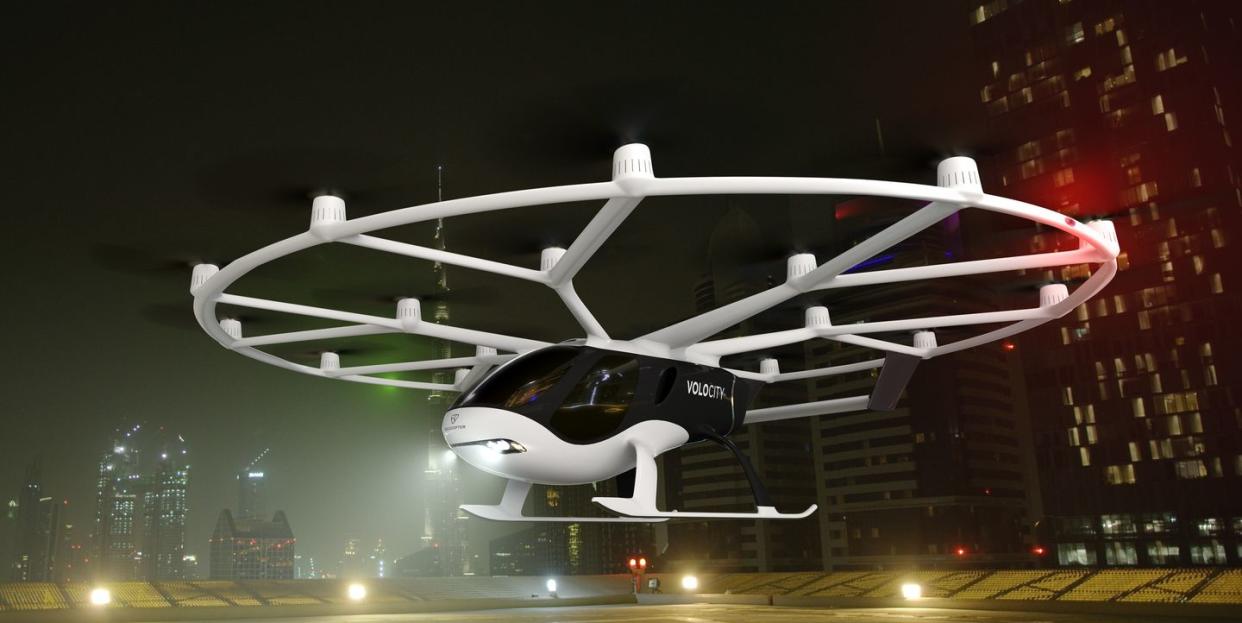We Could Be Getting Closer to the First Flying Taxi

German company Volocopter has unveiled the VoloCity, an electrical take-off and landing aircraft (eVTOL) that could be the first flying taxi.
Volocopter has been working on its eVTOLs since 2011. Two years ago in 2017, the company signed a contract with the government of Dubai to initiate tests of its VoloCity, where it performed public tests.
But even with a working VoloCity, there's still the infrastructure of flying taxis to build out.
The race toward flying taxis continues, with German company Volocopter unveiling its latest iteration, dubbed the VoloCity. The fourth-generation electrical take-off and landing aircraft (eVTOL), which the company hopes to build and certify for flying permits soon, is meant for flying within cities.
“The VoloCity is our most powerful Volocopter yet,” says Florian Reuter, CEO of Volocopter, in a press statement. “It is rigorously designed to meet the demands of Urban Air Mobility and incorporates all requirements of the SC-VTOL certification standard established by EASA in July 2019. It is a result of all insights we have gathered from our extensive testing programs over the past years. With the VoloCity we will open the first commercial routes and bring Urban Air Mobility to life.”
What makes our air taxi uniquely #Volocopter? It's our committment to the inner city mission. What exactly that means, you can learn in our white paper by our CTO @jhboelens here: https://t.co/3vpRatcwoS#airtaxi #certification #mobility #urbanisation #innovation #evtol #airtaxi pic.twitter.com/r2ghw77gNe
— Volocopter (@volocopter) August 2, 2019
The VoloCity won't be able to match the speed of a ground taxi on the open road. Its planned speed is 110 km/h, or a little over 68 mph. It'll have a range of 35 km, or 21.7 miles. But Volocopter hopes the VoloCity doesn't need to hit top speeds or have extended range, at least at first.
Volocopter has been working on its eVTOLs since 2011. Two years ago in 2017, the company signed a contract with the government of Dubai to initiate tests of its VoloCity, where it performed public tests.
"The learnings of over 1,000 test flights on previous Volocopter generations and market research with several hundred potential customers have informed the design and technical specifications of the VoloCity," reads the company's press release. "The result is an aircraft with visible improvements that still stays true to the well-known Volocopter technical and safety features: 18 rotors, redundancy in all critical systems, a low noise signature and a rigid commitment to the inner-city mission."
While testing will continue, the company still has a lot of work to do. Even with a working VoloCity, there's still the infrastructure of flying taxis to build out. The company says it's working on "building up the operational environment such as the physical take-off and landing infrastructure and integrating into air traffic management systems of interested cities."
Civic infrastructure is a challenge for any company, no matter how ambitious. Just ask Elon Musk's Boring Company.
You Might Also Like

